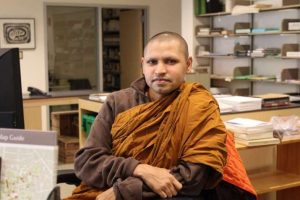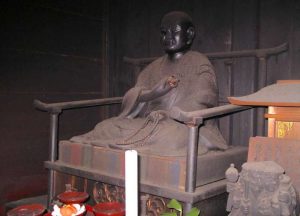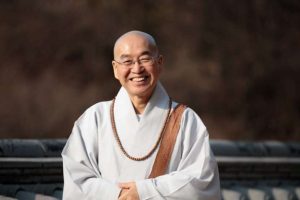The prominent socially engaged Buddhist activist and social critic Sulak Sivaraksa, founder of the International Network of Engaged Buddhists (INEB), was a spiritual friend and student of Thich Nhat Hanh for more than 40 years, drawing inspiration from the Zen master’s teachings and lived example of engaged Buddhism. Here Sulak offers a touching tribute to his friend and fellow engaged Buddhist.
Sulak, 88, is a renowned scholar, author, and humanitarian. He was nominated for the Nobel Peace Prize in 1994, and became a recipient of Sweden’s Right Livelihood Award (also known as the Alternative Nobel Prize) in 1995, the UNPO (Unrepresented Nations and Peoples Organization) Award in 1998, the Indian Millennium Gandhi Award in 2001, and the 2011 Niwano Peace Prize Right Livelihood Award.
In 1989, Sulak co-founded INEB with a group of Buddhist and non-Buddhist thinkers and social activists. Connecting engaged Buddhists around the world, INEB works promote understanding, cooperation, and networking among inter-Buddhist and inter-religious groups, and to actively address urgent global issues such as human rights, conflict resolution, and environmental crises.
INEB’s members include monks, nuns, social workers, and academics from more than 25 countries in Asia, Australasia, Europe, and North America, working together under the umbrella of kalyana-mittata (Pali. spiritual friendship). While founded in and motivated by the Buddhadharma, INEB nevertheless welcomes members from all spiritual traditions and recognizes the importance of interfaith activities, stating: “INEB’s philosophy and practice is based on compassion, social justice, non-violence, and co-existence as put forth by Gautama the Buddha. The network’s core mission is to confront and end suffering using analysis and action guided by the Four Noble Truths.” (INEB)
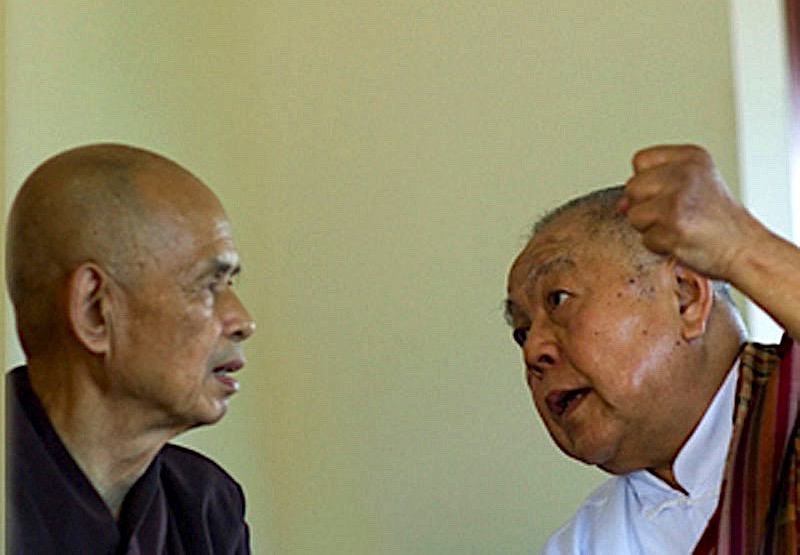
Thich Nhat Hahn – My Friend and My Teacher
The Vietnamese Zen Buddhist monk Thich Nhat Hanh—my friend and my teacher—died on 22 January 2022. Thay (meaning “teacher”) lived an extraordinary life of socially engaged Buddhism. The Dalai Lama recently wrote that the best way we can pay tribute to Thay is to continue his work to promote peace in the world. I agree, and I thought that I would take this opportunity to reflect on the Thay’s life and legacy.
Thay was born Nguyen Xuan Bao in Hue on 11 October 1926. He joined a Zen monastery as a novice monk at 16. Upon his full ordination in 1949, he assumed the Dharma name Thich Nhat Hanh. Thich is an honorary family name used by Vietnamese monks and nuns. Thay’s study of the Buddha’s teachings coincided with political upheaval in Vietnam and eventually war that started in 1955.
Thay went to the United States in 1961 to study at Princeton and soon was appointed as a lecturer in Buddhism at Columbia University. In 1963, he returned to Vietnam and continued to organize monks and laypeople in nonviolent peace efforts. He established schools for activists, including Van Hanh Buddhist University in Saigon; founded the La Boi Publishing House; and wrote essays, books, and poems in several languages, inspiring a generation of peace advocates.
In 1964, Thay wrote and published the poem “Condemnation” in a Buddhist weekly, that in part read:
Whoever is listening, be my witness:
I cannot accept this war.
I never could I never will.
I must say this a thousand times before I am killed.
I am like the bird who dies for the sake of its mate,
dripping blood from its broken beak and crying out:
“Beware! Turn around and face your real enemies
—ambition, violence, hatred, and greed.”
Thay was labeled an “antiwar poet,” and was denounced as a pro-Communist propagandist.
When Thay traveled in the US and Europe in 1966 with a mission to call for an end to hostilities in Vietnam, he met Dr. Martin Luther King, Jr., who the following year nominated Thay for the Nobel Peace Prize, saying: “Thich Nhat Hanh’s ideas for peace, if applied, would build a monument to ecumenism, to world brotherhood, to humanity.” Thomas Merton, after meeting Thay at Gethsemani Abbey in Kentucky in 1966, described him as “my brother” because of their common views.
Thay published a highly personal book about the war in 1967 titled Vietnam: Lotus in a Sea of Fire, which narrates his journey of transforming his religious beliefs into social action and his commitment to nonviolent conflict resolution. It was in this book that he articulated “engaged Buddhism,” a notion that greatly influenced Buddhist thinkers in Asia, including myself, and inspired spiritually inclined activists in the West.
An accomplished Buddhist scholar, Thay was fluent in Vietnamese, French, English, and Mandarin. He wrote in a way that transcends religious dogma and attracts readers of all faiths. In his work he places great importance on being “aware of the suffering created by fanaticism and intolerance” and is determined not to be “idolatrous about or bound to any doctrine, theory, or ideology, even Buddhist ones.”
“Our own life must be our message,” he often said.
While still in America in 1967, Thay received messages from Buddhist leaders in Vietnam telling him not to return lest he be imprisoned or assassinated. Thay then began a life in exile that would last 39 years.

I first met Thay in Colombo, Sri Lanka, in 1974, at an interfaith dialogue that the World Council of Churches had organized for Buddhist, Christian, Hindu, Jewish, and Muslim social activists. The group took an excursion to pay their respects to a famous relic of the Buddha in Kandy, and were received at the temple by Sri Lanka’s highest Buddhist dignitary, the Sangha Maha Nayaka. Thay had brought along a statement he had drafted in opposition to the Vietnam War, hoping to collect signatures in support. Because of the long history of close relationship between Thai and Sri Lankan Buddhists, Thay asked me to present the statement to the Sangha Maha Nayaka and request his endorsement. But the elderly Sinhalese monk told us: “No, I won’t sign this. I don’t want to be like the Dalai Lama and lose my country. Monks shouldn’t be involved in politics.”
Despite this disappointment, the occasion caused a mutual respect and camaraderie to arise between me and Thay. Our friendship continued as we both increased our social activism—my own in Southeast Asia, and Thay working the halls of power in the US and France to promote peace in Vietnam.
In 1975, I invited Thay to a three-week seminar I was organizing in northern Thailand, supported by the Quakers. Young people from various Southeast Asian countries came together in Chiang Mai to study nonviolence, to explore the power of the written word, to meditate and pray, and to spend time with senior activists like myself, Thay, and Swami Agnivesh from India. While the seeds of our friendship had been sown in Sri Lanka, it was on a mountain above Chiang Mai that our kalyana-mittata, spiritual friendship, blossomed. I watched Thay teach the young activists through his eloquent poetry and his gentle presence. Thay shared some of his writings—a manual for young meditators—that had been collected into a draft titled The Miracle of Being Awake. I witnessed the powerful effect Thay’s writing had on everyone, including myself, and I decided to publish it for the first time in English in Thailand. The title was later changed to The Miracle of Mindfulness, which went on to become a worldwide bestseller, translated into more than 30 languages.
Thay’s articulation of Buddhist activism arose in the context of war. He coined the English phrase “engaged Buddhism,” which emerged from his writings in Vietnamese that stressed “renewing Buddhism” and “a Buddhism updated” (the translated title of Thay’s 1965 book Dao Phat Hien Dai Hoa), concepts that he combined with the French phrase le bouddhisme engagé. While many academics and activists have since tried to define what engaged Buddhism is, Thay is clear that what the Buddha taught more than 2,500 years ago was an ideal of acting within society, not withdrawing from it. The Buddhist path is by definition engaged with people because it deals with the suffering we encounter in ourselves and in others, right here and right now. I tend to use the term “socially engaged Buddhism,” a phrase that was spread widely by Parallax Press’s publications in the 1980s and 1990s, and by the Buddhist Peace Fellowship newsletter in America (which today has evolved into Turning Wheel Media).
After the end of the Vietnam War, Thay still could not return to his country. He was not welcomed in Vietnam by the US-backed government in the 1960s and early 1970s, and neither by the Communists, who have ruled the country ever since—both were afraid of Thay’s activism and anti-war stance. From his home-in-exile in Paris, Thay worked tirelessly to help his people. We assisted him in raising money through Bread for the World, the Asian Cultural Forum on Development, and other organizations, to ship rice into Vietnam in the mid-1970s, to help the fleeing boat people, and to facilitate adoptions of Vietnamese orphans.
In October 1976, I too was exiled from my home country during the bloody coup in Bangkok. I took the opportunity to stay with Thay in a small apartment in Paris, and we also visited a small farm outside the city that he named the Sweet Potato Community. The community later moved to southwestern France and established Plum Village, one of the West’s largest Buddhist monasteries, with hundreds of resident monks and nuns, and where thousands of people from all over come annually to study Thay’s teachings on mindfulness and meditation. He later established monastic communities in Germany, Hong Kong, Thailand, and the United States, as well as meditation centers around the world, gaining an ever-growing global following.
I have fond memories of staying with Thay in his one-room apartment in France. When I would awake in the morning, Thay was already seated upright in meditation, well before dawn. Thay was showing me, by way of example, the disciplined life of a meditator. After I roused myself, Thay taught me mindfulness of breathing and other meditation techniques. Although I had learned meditation as a novice monk, I had not cultivated the practice afterward. Such quiet periods, and long sessions of drinking tea with minimal conversation, were uncommon in my life of constant action. These weeks of meditation with Thay were joyful. When I experience strong emotions like anger, I always practice what Thay taught me so many years ago.
In the 1980s and 1990s, Thay rose to worldwide prominence as a poet, author, and meditation teacher, with many meditation centers to manage. Sometimes, when we would meet during these years in the spirt of kalyana-mittata, I expressed concern that Thay’s organization was getting too large and losing the spirit of socially engaged Buddhism. Thay always listened to my concerns. Matteo Pistono’s book Roar: Sulak Sivaraksa and the Path of Socially Engaged Buddhism delves deeply into my spiritual friendship with Thay.
In 2005 and 2007, Thay was allowed to return to Vietnam to teach and publish books, tour the country, and meet with members of his Buddhist order. His highly publicized visits created controversy among some Vietnamese Buddhist activists, who criticized Thay for failing to speak out against the current government’s alleged human rights abuses and poor record on religious freedom.
In 2013, Thay came to Thailand to visit the newly established Thai Plum Village International Practice Center outside Bangkok. We reminisced about our 40-year friendship, drank tea, and meditated. Thay gifted me an ink calligraphy that he painted of a Zen circle (enso) around the phrase “You are, therefore, I am.” I meditate upon this bodhisattva-inspired phrase regularly.
That was the last time I saw Thay as he suffered a severe stroke in November of 2014. He was unable to speak after the stroke but could communicate through gestures. Thay received expert medical care and support from Plum Village and eventually returned to his home in the Tu Hieu Temple in Hue, Vietnam, and that is where he passed away at the age of 95.
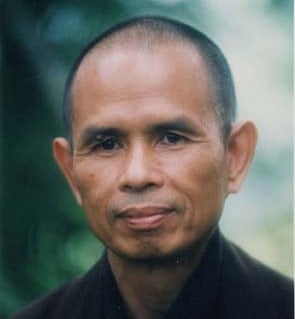
Thay wrote and taught often about death and dying, and in his book No Death, No Fear, he concludes:
This body is not me; I am not caught in this body, I am life without boundaries, I have never been born and I have never died. Over there the wide ocean and the sky with many galaxies All manifests from the basis of consciousness. Since beginningless time I have always been free. Birth and death are only a door through which we go in and out. Birth and death are only a game of hide-and-seek. So smile to me and take my hand and wave good-bye. Tomorrow we shall meet again or even before. We shall always be meeting again at the true source, always meeting again on the myriad paths of life.
See more
International Network of Engaged Buddhists
Thich Nhat Hanh memorial practice resources (Plum Village)
Thich Nhat Hanh’s full biography (Plum Village)
The essential teachings of Thich Nhat Hanh (Plum Village)
Free mindfulness app with guided meditations by Thich Nhat Hanh (Plum Village)
The Way Out is In official Plum Village podcast (Plum Village)
Related news reports from BDG
Plum Village Announces the Passing of the Internationally Beloved Buddhist Teacher Thich Nhat Hanh
Engaged Buddhism: INEB to Join PeaceCon@10 Forum on COVID, Climate, and Conflict
Engaged Buddhism: INEB Launches Sangha for Peace to Tackle Regional Religious and Ethno-Nationalist Tensions
INEB, Clear View Project Launch Humanitarian Appeal for Buddhist Monastics in Myanmar
Engaged Buddhist Sulak Sivaraksa Speaks Out During Thai Pro-Democracy Protests
Related features from BDG
The Cloud Is Not Lost – In Honor of Thích Nhất Hạnh
Compassion and Kalyana-mittata: The Engaged Buddhism of Sulak Sivaraksa



